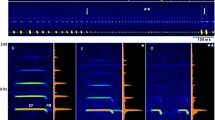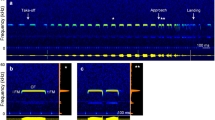Summary
-
1.
Doppler shift compensation (DSC) behavior of the greater horseshoe bat,Rhinolophus ferrumequinum, was compared during spontaneous emission of echolocation sounds and during electrically elicited vocalization.
-
2.
At low to moderate intensities of electrical stimulation in regions near the midbrain periaqueductal grey, the Doppler shift compensation performance showed the same characteristics as during spontaneous emission. This was also true for artificially increased emission rates (Fig. 1).
-
3.
Electrically induced high sound emission rates improved the dynamic response properties of the Doppler shift compensation control system (Figs. 2, 3, 4).
-
4.
At deep caudal stimulation sites in the midbrain electrical stimulation at moderate to high intensities led either to reversible suppression of DSC, or to reduction and distortion of the compensation (Fig. 5).
Similar content being viewed by others
Abbreviations
- DSC :
-
Doppler shift compensation
- RF :
-
resting frequency
References
Jürgens U, Pratt R (1979) Role of the periaqueductal grey in vocal expression of emotion. Brain Res 167:367–378
Müller-Preuss P, Ploog D (1983) Central control of sound production in mammals. In: Lewis B (ed) Bioacoustics. Academic Press, New York London, pp 125–146
Müller-Preuss P, Newman JD, Jürgens U (1980) Anatomical and physiological evidence for a relationship between the ‘cingular’ vocalization area and the auditory cortex in the squirrel monkey. Brain Res 202:307–316
Novick A, Griffin DR (1961) Laryngeal mechanisms in bats for the production of orientation sounds. J Exp Zool 148:125–145
Rübsamen R, Betz M (1986) Control of echolocation pulses in the nucleus ambiguus of the rufous horseshoe bat (Rhinolophus rouxi) I. Single unit recordings in the motor nucleus of the larynx in actively vocalizing bats. J Comp Physiol (in press)
Schuller G (1977) Echo delay and overlap with emitted orientation sounds and Doppler shift compensation in the bat,Rhinolophus ferrumequinum. J Comp Physiol 114:103–114
Schuller G, Pollak G (1979) Disproportionate frequency representation in the inferior colliculus and Doppler-compensating greater horseshoe bats: Evidence for an acoustic fovea. J Comp Physiol 132:47–54
Schuller G, Rübsamen R (1981) Laryngeal nerve activity during pulse emission in the CF-FM bat,Rhinolophus ferrumequinum I. Superior laryngeal nerve (external motor branch). J Comp Physiol 143:317–321
Schuller G, Suga N (1976a) Laryngeal mechanism for the emission of CF-FM sounds in the Doppler shift compensating bat,Rhinolophus ferrumequinum. J Comp Physiol 107:253–262
Schuller G, Suga N (1976b) Storage of Doppler shift information in the echolocation system of the CF-FM-bat,Rhinolophus ferrumequinum. J Comp Physiol 105:9–14
Schuller G, Beuter K, Schnitzler H-U (1974) Response to frequency shifted artificial echoes in the batRhinolophus ferrumequinum. J Comp Physiol 89:275–286
Schuller G, Beuter K, Rübsamen R (1975) Dynamic properties of the compensation system for Doppler shifts in the bat,Rhinolophus ferrumequinum. J Comp Physiol 97:113–125
Schnitzler H-U (1968) Die Ultraschallortungslaute der Hufeisen-Fledermäuse (Chiroptera-Rhinolophidae) in verschiedenen Orientierungssituationen. Z Vergl Physiol 57:376–408
Suga N, Schlegel P, Shimozawa T, Simmons J (1973) Orientation sounds evoked from echolocating bats by electrical stimulation of the brain. J Acoust Soc Am 54:793–797
Suthers RA, Fattu JM (1982) Selective laryngeal neurotomy and the control of phonation by the echolocating bat,Eptesicus. J Comp Physiol 145:529–537
Author information
Authors and Affiliations
Rights and permissions
About this article
Cite this article
Schuller, G. Influence of echolocation pulse rate on Doppler shift compensation control system in the greater horseshoe bat. J. Comp. Physiol. 158, 239–246 (1986). https://doi.org/10.1007/BF01338567
Accepted:
Issue Date:
DOI: https://doi.org/10.1007/BF01338567




